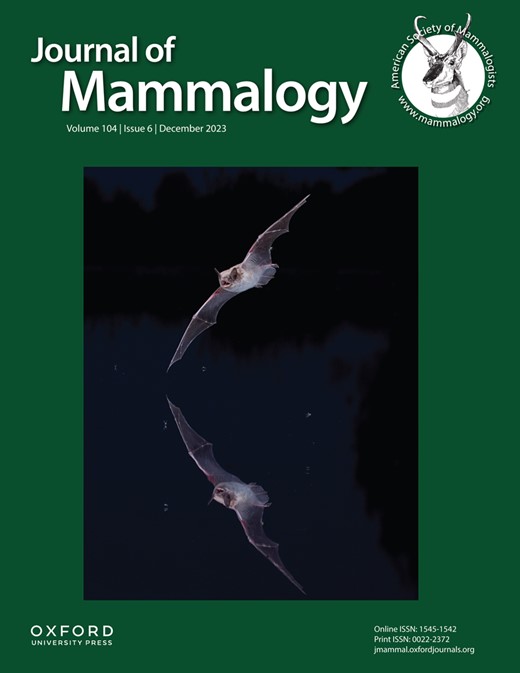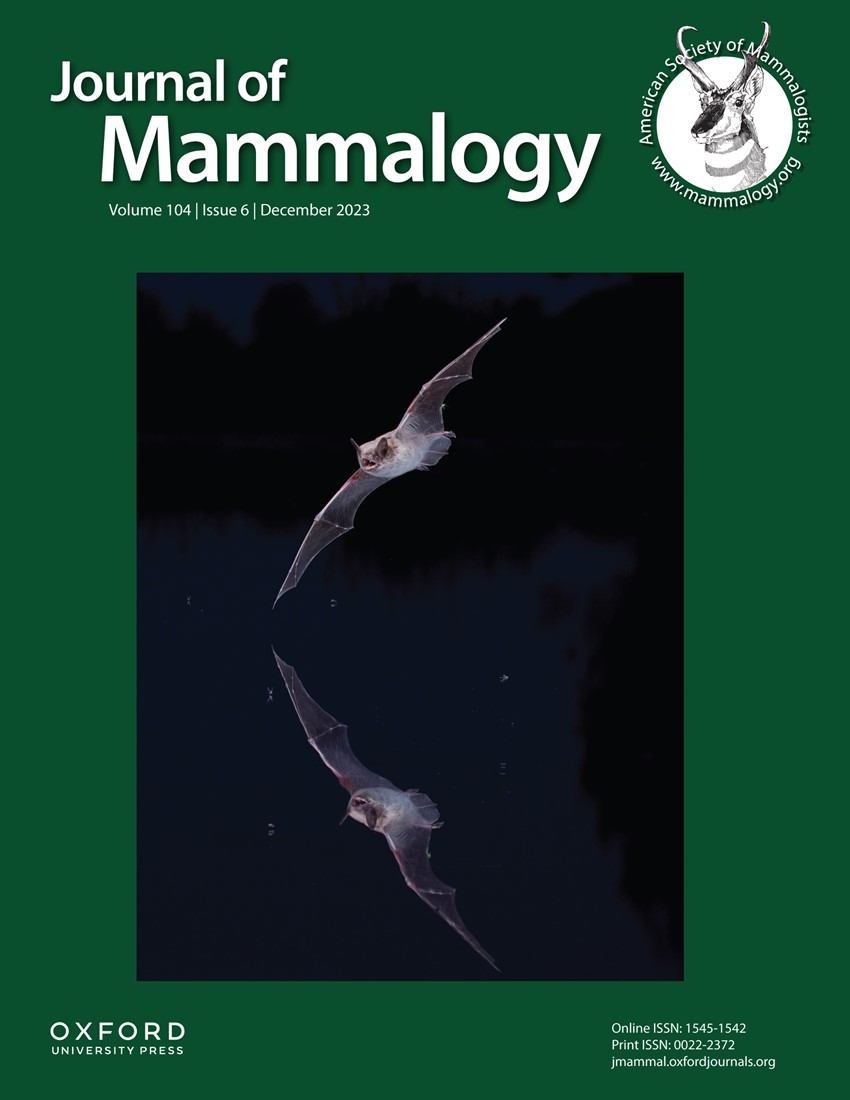
Cover image

Volume 104, Issue 6, December 2023
Feature Articles
Space use patterns of two large carnivores: Puma (Puma concolor) and Maned Wolf (Chrysocyon brachyurus) in tropical agroecosystems
Brazilian carnivores in agricultural areas: pumas display affinity for stations closer to watercourses, while maned wolves avoid human structures and use unpaved roads. Both species demonstrate adaptability to agroecosystems; however, concerns arise from habitat degradation and road risks.
Female pond bats hunt in other areas than males and consume lighter prey when pregnant
When pregnant or lactating, female pond bats occur mainly in peatland with shallow waterways, separate from males. Morphological and molecular analyses of fecal pellets show that this spatial segregation of sexes coincides with sex-specific diets—pregnant females highly depend on small, abundant prey like nonbiting midges and mosquitoes, which might reflect habitat selection based on energy requirements.
Using biological traits to assess diet selection: the case of the Pyrenean Desman
How do predators select prey? This study shows that biological traits give a more coherent picture of diet selection than prey taxonomy.
Rocky rule: the idiosyncrasy of spatial and temporal size variation in mammals
We found little support for either spatial or temporal patterns of body size variation consistent with Bergmann’s rule across morphological traits in multiple species of North American mammals over the past 120 years.
The utility of alpine cave fossil assemblages for zoological census: an example from northern Utah, United States
In this study, we seek to highlight the value of Holocene cave skeletal assemblages as a tool for establishing zoological baselines for mammalian communities predating recent human impacts. We do this by analyzing the mammalian fossils from Boomerang Cave, a high-elevation site in Utah.
Rates of seasonal fuel loading do not differ by sex or overwintering strategy in three species of bats
Temperate-zone bats avoid the challenges of cold temperatures and low prey density during winter via use of migration, hibernation, or a combination of both. We found that three species of bats, which use different overwintering strategies, did not differ markedly in their rate of change in energy storage (fuel loading) throughout the year.
Apparent annual survival of female eastern small-footed bats (Myotis leibii) roosting in Arkansas bridges
Survival rates of female eastern small-footed bats were studied in colonies roosting in bridges in the Ozark Mountains of Arkansas. Overall female survival was 0.643 with first-year juvenile survival of 0.472 and adult survival of 0.744, which is similar to that of other Myotis spp. bats. Stability in both the number of bats encountered over the 8 years of the study and their survival rates suggests that the impact of white-nose syndrome on these colonies has been marginal.
Multiscale influences on Elk (Cervus canadensis) calving site selection across a fragmented Appalachian landscape
Parturient ungulates are often faced with a trade-off between high-quality forage and protection for their neonate when selecting a birth site. We found that reintroduced Kentucky Elk selected habitat during parturition at multiple scales, reflecting trade-offs in perceived habitat operating not only directly near the birth site but also across the surrounding landscape.
Direct and indirect landscape-scale pathways structure carnivore communities in an agro-prairie ecosystem
Carnivore communities occurring in human-modified landscapes are structured through multiple direct and indirect pathways. Carnivore richness in agro-prairie ecosystems is enhanced with greater water availability, prey abundance, and coverage of native prairie land cover. Surprisingly, carnivore richness is also positively influenced by greater coverage of agriculture on the landscape, though carnivore communities in these areas are notably lacking prairie-obligate species and more representative of synanthropic species.
Uncertainty during migration: the role of predictable resources in unpredictable conditions in determining movement in Woodland Caribou (Rangifer tarandus)
Migrations face uncertain meteorological conditions. These conditions affect habitat selection differently during movement and stopovers.
What drives prey selection? Assessment of Tiger (Panthera tigris) food habits across the Terai-Arc Landscape, India
A sneak-peak into Tiger prey selection patterns in a human-dominated mosaic of protected and nonprotected areas of the Terai-Arc Landscape of India. This article talks about how Tigers food habit changes depending on resource availability at a landscape scale. The results have critical importance in reducing human–tiger conflict in this landscape.
Lion (Panthera leo) movements in a multiuse area of the eastern Panhandle of the Okavango Delta, Botswana
African Lion (Panthera leo ) movements and home range overlap in the human-dominated eastern Panhandle of the Okavango Delta, Botswana.
Factors influencing timing of puberty in Mexican gray wolves (Canis lupus baileyi)
Sperm was found in samples of more than half the young males aged 8–10 months and half of those were judged fertile based on percentages of motile sperm with normal morphology. Likelihood of producing sperm was related to body weight, implicating nutrition as a major influence. Latitude and date of semen collection relative to peak breeding season were also associated with sperm production, but living in a family group had no effect.
Diet selection in the Coyote Canis latrans
Coyotes preferentially prey on Dall’s Sheep, White-tailed Deer, Eastern Cottontail Rabbit, and California Vole, while they avoid depredating small mammals, carnivorans, and arboreal species. These prey preferences reflect their predatory behavioral flexibility in being able to hunt alone or in groups. Understanding predator–prey preferences enables us to begin predicting their responses to variation in bottom-up dietary resources.
The implications of large home range size in a solitary felid, the Leopard (Panthera pardus)
Bringing all the boys to the yard. Male leopards travel further and faster to find females and to avoid other males. Whereas females are more concerned with food than other leopards.
Seasonal and sex-specific changes in the gastrointestinal tracts of Peromyscus maniculatus
In this study, we examine seasonal and sex-specific changes in the gastrointestinal tracts of a common North American small mammal. We show that the gastrointestinal tracts of winter mice are up to 35% longer and 18% heavier than those of summer mice. This was directly coincident with decreased dietary quality in the winter months.
Forelimb morphology as an adaptation for burrowing in kangaroo rat species (genus Dipodomys) that inhabit different soil substrates
Kangaroo rat species display morphological variation associated with their forelimbs. Species that construct burrows in dense soils have correspondingly robust forelimb features, which suggests that these animals are morphologically specialized to their substrate and may help to explain their limited geographic range. Appreciating the role of soil specialization in habitat occupancy may provide important information as conservation decisions are made on behalf of these animals.
The influence of landscape features on the population connectivity and genetic structure of the Edible Dormouse Glis glis in Poland
We investigated the genetic structure of dormice (Glis glis ) representing five populations, inhabiting forest complexes in southwestern Poland that differed in their degree of fragmentation and isolation. The basic parameters of genetic variability in these populations were lower in dormice inhabiting small forest complexes, isolated by cultivated areas. Genetic differentiation between pairs of populations corresponded to the geographic distribution of individual populations, that is, individuals from small isolated populations were clearly genetically different from each other and from dormice from a large contiguous forest complex, indicating limited gene flow between populations. Therefore, it seems that the scenario of a slow, long-term process of loss of genetic diversity due to habitat fragmentation is becoming a real threat to this species.
Southern Red-backed Vole (Myodes gapperi) habitat associations in northern New England forests
In northern New England, Southern Red-backed Voles have an affinity for forest stands with Eastern Hemlock and microhabitats near water and with an abundance of red maple and deep leaf litter. Loss of Eastern Hemlock following infestation by the Hemlock Woolly Adelgid may trigger population declines of the Southern Red-backed Vole.
Social play predicts caution in juvenile Belding’s ground squirrels (Urocitellus beldingi)
We evaluated the relationship between social play and development of cautious responses in juvenile Belding’s ground squirrels. Juveniles who engaged in social play at higher rates across the play interval had greater increases in caution in response to a potential threat, suggesting that social play may promote refinement of temperament along the caution–boldness continuum in young squirrels.
Life history variation of the Hairy-tailed Akodont (Necromys lasiurus, Rodentia, Sigmodontinae) in the Caatinga biome of northeastern Brazil
That rodents excel at reproduction, we know. However, what we found is that the Hairy-tailed Akodont (Necromys lasiurus ), a Neotropical rodent, can tune its reproductive efforts intimately to environmental variability. Climatological variables influence the weight of mothers and that impacts litter size. Variability is one key element for success and possibly explains why this species is so widely distributed and successful in persisting in the dry shrublands of the Caatinga.
Genetic evidence for variability in the social mating system of the Midday Gerbil (Meriones meridianus)
Supplemental feedings affect diet seasonality and niche width in urban Eurasian red squirrels
How do animals modify their diets to live in urban environments? We report the dietary modifications in urban Eurasian red squirrels that are fed by citizens through a year, using stable isotope analysis and direct observation.
Molecular and morphological evidence support a new species of Asiatic short-tailed shrew (Eulipotyphla: Soricidae)
We describe a new species of Asiatic short-tailed shrews, Parablarinella latimaxillata, from Dabie Mountains, eastern China. The new species is the easternmost distribution of Asiatic short-tailed shrews, which is geographically distant from the other congeners. The divergence between P. latimaxillata and its sister species P. griselda occurred ca. 3.08 million years ago, which may have been affected by East Asia’s topographic and climate changes in the late Pliocene.


